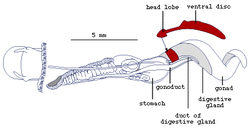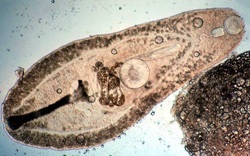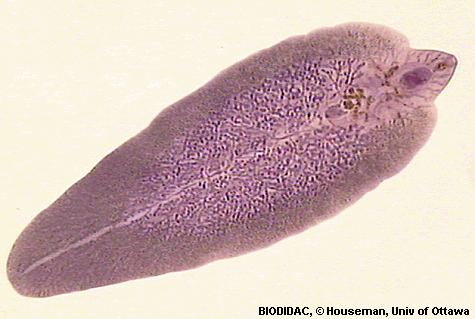Class Trematoda
Basics:The approximately eight thousand species of trematoda are called flukes, because of their wide flatten shape. Almost all Adult flukes are vertebrate parasites , while the younger ones attach themselves to invertebrates or encysted on plants. The size of them can range from 1 mm to 6 cm in lenth , and they feed on cells and cell fragments. The trematoda has a mouth , pharynx , and digestive tract that divides into two branched , blind ending cecae. The body wall for all flukes is very similar to each other, and the epidermis consist of an outer layer called the tegument. The tegument forms syncytium and the outer zone of the tegument consist of gylcocalyx. The glycocalyx helps in transportation of , nutrients , and waste all across the body wall. The cytoplasmic bodies that contain the the trematodas nuclei and organelles lie below the basement membrane and slender cells have cytoplasmic brides that connect the bodies to the outer zonbe tegument.

Subclass Aspidogastrea: are a small group of flukes that are primarily internal parasites of molluscs. A large organ called the opisthaptor covers the ventral surface of the animal. This is a very strong attached organ , and the ridges or septa usually subdivide it. The oral sucker is absent and the life cycle of a aspidogastrean may be one or two host.

Subclass Digenea: The vast majority of all flukes belong to this class , this class has one adult form and one or more larva forms. Digenetic flukes need at least two host to complete their life cycle. In there larval stages they may go through several fazes , In the adult stage they become endoparasites in the blood streams ,digestive tract, or other visceral organs. The adhesive organs of Digenea are two large suckers called the oral sucker and acetabulum. The eggs ofdigenetic trematodes are oval and have a hatch called an operculum, and when the egg reaches freshwater it opens and a Miracidium is released. The miracidium finds its first host and penetrates it , Then it looses its cilia and become sporocyst. Sporocyst contain embryonic cells that can contain rediae or daughter sporocysts, these two larva can be mass produced through asexual reproduction from a single miracidium. The rediae or sporocysts then can asexually produce Cercariae, which have a digestive tract, suckers, and a tail. At this stage in development the cercaria will invade its second host encysts as a metacercaria, after it devours its second host the cercaria will develope into a adult

